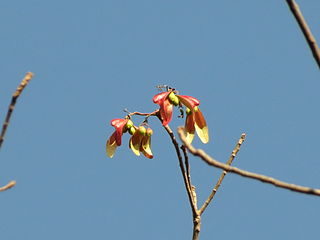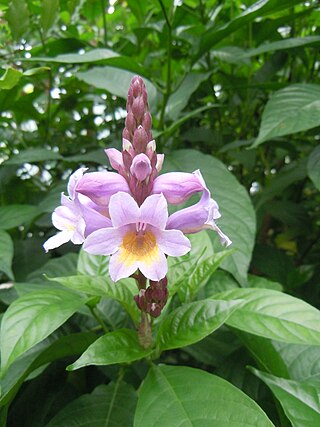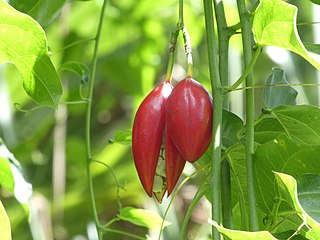
Meliaceae, the mahogany family, is a flowering plant family of mostly trees and shrubs in the order Sapindales.

Rafflesia, or stinking corpse lily, is a genus of parasitic flowering plants in the family Rafflesiaceae. The species have enormous flowers, the buds rising from the ground or directly from the lower stems of their host plants; one species has the largest flower in the world. Plants of the World Online lists up to 41 species from this genus, all of them are found throughout Southeast Asia.

Knightia is a small genus of the family Proteaceae endemic to New Zealand, named in honor of Thomas Andrew Knight. One extant species, K. excelsa (rewarewa) is found in New Zealand. Two further Knightia species are found in New Caledonia, although they were placed in the genus Eucarpha by Lawrie Johnson and Barbara Briggs in their influential 1975 monograph "On the Proteaceae: the evolution and classification of a southern family", a placement supported in a 2006 classification of the Proteaceae. A fossil species from upper Miocene deposits in Kaikorai has been described as Knightia oblonga. Knightia has been placed in the tribe Roupaleae of the subfamily Grevilleoideae.

Dysoxylum is a genus of rainforest trees and shrubs in the flowering plant family Meliaceae. About 34 species are recognised in the genus, distributed from India and southern China, through southeast Asia to New Guinea, Solomon Islands, and Australia. The name Dysoxylum derives from the Greek word ‘Dys’ meaning "bad" referring to "ill-smelling" and ‘Xylon’ meaning "wood".
Heliciopsis is a genus of about fourteen species of trees, constituting part of the flowering plant family Proteaceae. They grow naturally in Myanmar, Indo-China, China, Thailand, Peninsular Malaysia, Borneo, Sumatra, Java (Indonesia) and the Philippines. The name means similar to the plant genus Helicia. Its closest relatives are Athertonia (Australia) and Virotia.

Rafflesia zollingeriana is a species of flowering plant in the family Rafflesiaceae, native to Java. Of three species of Rafflesia known from Java this species has always been the most rare and restricted, it is only known from collection locales in Banyuwangi Regency, Jember Regency and Lumajang Regency, southern East Java. It was first scientifically collected in 1902 by Sijfert Hendrik Koorders on the eastern flanks of Mount Puger Watangan, a forested hill near the beach, who described it as a new species in 1918. Many decades later a flowering plant was discovered in Meru Betiri National Park, also in the Jember Regency somewhat further down the coast to the east.

Wallaceodendron celebicum is species of flowering plant in the legume family, Fabaceae. It is a tree native to the Philippines and Sulawesi. Typical habitat is tropical coastal and inland rain forest from sea level to 850 meters elevation. It is the sole species in genus Wallaceodendron. The genus belongs to the mimosoid clade of the subfamily Caesalpinioideae.

Talipariti is a genus of plants in the mallow family Malvaceae. It consists of 22 species, which are exclusively tropical except for one species whose range extends into temperate areas of Japan and Korea. Most authors now treat these species as part of the genus Hibiscus, in which case they form the section Hibiscus sect. Azanzae.

Chisocheton is a genus of trees in the family Meliaceae. The genus name comes from the Greek schizos and chiton meaning "split tunic", referring to the lobed staminal tube of C. patens. Their range is from India and tropical China, throughout Malesia and south to New South Wales and Vanuatu.
Chisocheton koordersii is a tree in the family Meliaceae. It is named for the Dutch botanist Sijfert Hendrik Koorders.

Pterocymbium is a genus in the family Malvaceae: in the subfamily Sterculioideae and previously placed in the Sterculiaceae. In Indonesia, P. tinctorium (Kelumbuk) is a significant timber tree.

Phlogacanthus is a genus of flowering plants in the family Acanthaceae and tribe Andrographideae. Its distribution includes India through to Indo-China, southern China, Java, and Sulawesi.
Anna Koorders-Schumacher (1870–1934) was a German-born Dutch botanist. She was married to Dutch botanist Sijfert Hendrik Koorders, with whom she co-authored books on Javanese plants
Disepalum is a genus of plants in the family Annonaceae and tribe Annoneae.

Koordersiodendron is a monotypic genus of flowering plants belonging to the family Anacardiaceae. It only contains one known species, Koordersiodendron pinnatum(Blanco) Merr.
Pseuduvaria oxycarpa is a species of plant in the family Annonaceae. It is native to Sulawesi. Sijfert Hendrik Koorders, the Dutch botanist who first formally described the species, named it after the pointed tips of its fruit.
Sijfert Hendrik Koorders was a Dutch botanist, who worked primarily on the flora of Java.

Adenia heterophylla, commonly known in Australia as the lacewing vine, is a climbing plant in the family Passifloraceae. It has a broad distribution spanning the equator, from the south eastern corner of China, through Indochina and Malesia, to northern Australia. In Australia it serves as a food plant for larvae of the glasswing, red lacewing and cruiser butterflies.
Reinwardtiodendron cinereum is a tree in the family Meliaceae, native to Southeast Asia. The specific epithet cinereum means "ashen", referring to the leaves' colour on drying.
Reinwardtiodendron kinabaluense is a tree in the family Meliaceae, native to Borneo. It is named for Mount Kinabalu.











